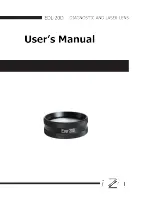
11
instruCtions for tHe
monoVision Wearer
•
You should be aware that as with any type of
lens correction, there are advantages and
disadvantages to monovision contact lens therapy.
The benefit of clear near vision in straight ahead
and upward gaze that is available with monovision
may be accompanied by a vision compromise
that may reduce your visual acuity and depth
perception for distance and near tasks.
• Some patients have experienced difficulty adapting
to monovision contact lens therapy. Symptoms,
such as mild blurred vision, dizziness, headaches
and a feeling of slight imbalance, may last for a brief
minute or for several weeks as adaptation takes
place. The longer these symptoms persist, the
poorer your prognosis for successful adaptation.
• You should avoid visually demanding situations
during the initial adaptation period. It is
recommended that you first wear these contact
lenses in familiar situations, which are not visually
demanding. For example, it might be better to be
a passenger rather than a driver of an automobile
during the first few days of lens wear. It is
recommended that you only drive with monovision
correction if you pass your state drivers license
requirements with monovision correction.
• Some monovision patients will never be fully
comfortable functioning under low levels of
illumination, such as driving at night. If this happens,
you may want to discuss with your eye care
professional having additional contact lenses
prescribed so that both eyes are corrected for
distance when sharp distance binocular vision is
required.
• If you require very sharp near vision during
prolonged close work, you may want to have
additional contact lenses prescribed so that both
eyes are corrected for near when sharp near
binocular vision is required.
• Some monovision patients require supplemental
spectacles to wear over the monovision correction
to provide the clearest vision for critical tasks.
You should discuss this option with your eye care
professional.
• It is important that you follow your eye care
professional’s suggestions for adaptation to
monovision contact lens therapy. You should
discuss any concerns that you may have during and
after the adaptation period.
•
The decision to be fit with a monovision
correction is most appropriately left to the
eye care professional in conjunction with you,
after carefully considering and discussing your
needs.
symbol referenCe guide
For label and cartons:
Indicates the CE Conformity
Marking and the Notified Body
Number
Member Green Dot Scheme
Sterile Using Steam or Dry Heat
Caution
Diameter
Use by Date (Expiration Date)
Batch Code
Authorized Representative in
European Community
Caution: Federal law restricts this
device to sale by or on the order
of a licensed practitioner
Diopter (Lens Power)
Base Curve
Sphere Power (Diopters)
Cylinder Axis (Degrees)
Cylinder Power (Diopters)
Storage Temperature
YYYY-MM-DD Effective Date






















